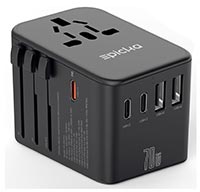Plug Sockets in Iran - Information about Plug Sockets and Electrical Standards in Iran
Key Takeaways
| Feature | Details |
|---|---|
| Plug Types | Type C (Europlug) and Type F (Schuko) |
| Standard Voltage | 230 V |
| Standard Frequency | 50 Hz |
| Power Adapters Needed | Yes, for devices with different plug types |
| Voltage Converters Needed | If devices are not compatible with 230V, a converter/transformer is required |
Introduction
Travelling to Iran offers a unique experience rich in culture and history. One crucial aspect to consider is how you will keep your electronic devices charged. Understanding the local plug sockets and electrical standards will help you prepare for your trip effectively.Photo by Majid Masajedi: https://www.pexels.com/photo/a-tower-in-the-city-at-night-9153155/
Types of Plug Sockets in Iran
In Iran, you will encounter two primary types of plug sockets:
- Type C (Europlug): Two round parallel pins, 4mm in diameter, 19mm apart. Suitable for low-power appliances.
- Type F (Schuko): Two round parallel pins, 4.8mm in diameter, 19mm apart, with two grounding clips. Suitable for high-power appliances.
Here's a visual representation of Iran's plug types and their specifications:
Voltage and Frequency
Iran operates on a standard voltage of 230 V and a frequency of 50 Hz. This is consistent with many countries in Europe and Asia. However, travelers from countries with different voltage standards, such as the United States (110 V), should verify their device compatibility to avoid any issues.
Do You Need a Power Adapter?
If your devices use a different plug type, you will need a power adapter to connect to Iranian sockets. For example, travelers from the United States or Canada, which use Type A and B plugs, will need an adapter for Type C or F sockets. It's advisable to purchase a universal travel adapter that accommodates multiple plug types to ensure you are prepared.

For more information on plug sockets in nearby regions, you can refer to these resources:
Voltage Converters and Dual Voltage Devices
Most modern electronic devices such as laptops, smartphones, and cameras are designed to handle a wide range of voltages (e.g., 110-240V). If your device is single-voltage and does not support 230V, you will need a voltage converter. Dual voltage devices do not require a converter, only a travel adapter.
Additional Resources
To further assist you in your travels within this region, here are some additional resources for plug sockets in other Middle Eastern countries:
Conclusion
Understanding Iran's plug sockets and electrical standards is essential for keeping your devices charged and ready for use. Make sure to equip yourself with the necessary adapters and converters to ensure a hassle-free trip.
Here's an informative video about using travel adapters:






